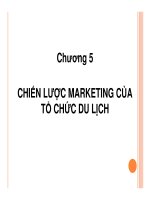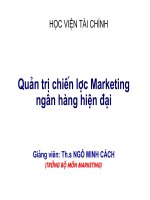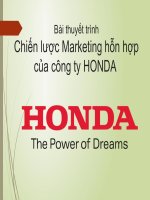slide CHIẾN LƯỢC MARKETING: DEVELOPING COMPETITIVE ADVANTAGE AND STRATEGIC FOCUS
Bạn đang xem bản rút gọn của tài liệu. Xem và tải ngay bản đầy đủ của tài liệu tại đây (1.3 MB, 23 trang )
TRƯỜNG ĐẠI HỌC VĂN LANG
KHOA THƯƠNG MẠI
CHAPTER 4: DEVELOPING COMPETITIVE
ADVANTAGE AND STRATEGIC FOCUS
ThS. Nguyễn Quốc Vương
Strengths, weaknesses,
opportunities, and threats: Which is
the most important? Why? How
might your response change if you
were the CEO of a corporation?
What if you were a customer of the
firm? An employee? A supplier?
10
© 2014 Cengage Learning. All Rights Reserved. May not be scanned, copied or duplicated, or posted to a publicly accessible website, in whole or in part.
Điểm mạnh, điểm yếu, cơ hội và mối
đe dọa: Cái nào quan trọng nhất? Tại
sao? Câu trả lời của bạn có thể thay
đổi như thế nào nếu bạn là Giám đốc
điều hành của một công ty? Nếu bạn
là khách hàng của cơng ty thì sao?
Một nhân viên? Một nhà cung cấp?
10
© 2014 Cengage Learning. All Rights Reserved. May not be scanned, copied or duplicated, or posted to a publicly accessible website, in whole or in part.
SWOT Analysis
A
widely used framework for organizing and
utilizing the pieces of data and information
gained from the situation analysis.
Encompasses
both internal and
external environments
One
of the most effective tools in the analysis
of environmental data and information
2
© 2014 Cengage Learning. All Rights Reserved. May not be scanned, copied or duplicated, or posted to a publicly accessible website, in whole or in part.
Making SWOT Analysis Productive
(Exhibit 4.2)
Stay
Focused
It is a mistake to complete one generic SWOT analysis
for the entire organization.
Search
Extensively for Competitors
Information on competitors is an important aspect of a
SWOT analysis. All four types of competition are
important.
Collaborate
with other Functional Areas
Information generated from the SWOT analysis can be
shared across functional areas.
3
© 2014 Cengage Learning. All Rights Reserved. May not be scanned, copied or duplicated, or posted to a publicly accessible website, in whole or in part.
Making SWOT Analysis Productive
(Exhibit 4.2) (continued)
Examine Issues from the Customers’ Perspective
Look for Causes, Not Characteristics
Causes for each issue in a SWOT analysis can often be
found in the firm’s and competitors’ resources.
Separate Internal Issues from External Issues
Failure to understand the difference between internal and
external issues is a major reason for a poorly conducted
SWOT analysis.
4
© 2014 Cengage Learning. All Rights Reserved. May not be scanned, copied or duplicated, or posted to a publicly accessible website, in whole or in part.
Breaking Down Managerial Clichés
(Exhibit 4.3)
5
© 2014 Cengage Learning. All Rights Reserved. May not be scanned, copied or duplicated, or posted to a publicly accessible website, in whole or in part.
Potential Issues to Consider in a
SWOT
Analysis (Exhibit 4.4)
Strengths
and Weaknesses
Presence or absence of
economies
Presence or absence of
resources
Presence or absence of
Presence or absence of
reputational resources
Opportunities
scale and cost
financial or human
functional skills
intellectual, legal or
and Threats
Conditions or changes in the customer
environment
Conditions or changes in the competitive
environment
© 2014 Cengage Learning. All Rights Reserved. May not be scanned, copied or duplicated, or posted to a publicly accessible website, in whole or in part.
6
Potential Issues to Consider in a
SWOT Analysis (Exhibit 4.4)
7
© 2014 Cengage Learning. All Rights Reserved. May not be scanned, copied or duplicated, or posted to a publicly accessible website, in whole or in part.
The SWOT Matrix (Exhibit 4.5)
8
© 2014 Cengage Learning. All Rights Reserved. May not be scanned, copied or duplicated, or posted to a publicly accessible website, in whole or in part.
Quantitative Assessment of
the SWOT Matrix (Exhibit
4.6)
9
© 2014 Cengage Learning. All Rights Reserved. May not be scanned, copied or duplicated, or posted to a publicly accessible website, in whole or in part.
Support or contradict this
statement:
“Given the realities of today’s economy
and the rapid changes occurring in
business technology, all competitive
advantages are short-lived. There is no
such thing as a sustainable competitive
advantage that lasts over the long
term.” Defend your position.
14
© 2014 Cengage Learning. All Rights Reserved. May not be scanned, copied or duplicated, or posted to a publicly accessible website, in whole or in part.
Support or contradict this
statement:
“Với thực tế của nền kinh tế ngày nay i th ực tế của nền kinh tế ngày nay c t ế của nền kinh tế ngày nay của nền kinh tế ngày nay a n ền kinh tế ngày nay n kinh t ế của nền kinh tế ngày nay ngày nay
và nh ững thay đổi nhanh chóng xảy ra ng thay đ ổi nhanh chóng xảy ra i nhanh chóng x ảy ra y ra
trong công ngh ệ kinh doanh, tất cả kinh doanh, t ất cả t c ảy ra
các l ợi thế cạnh tranh đều tồn tại i th ế của nền kinh tế ngày nay c ạnh tranh đều tồn tại nh tranh đ ền kinh tế ngày nay u t ồn tại n t ạnh tranh đều tồn tại i
trong th ời gian ngắn. Khơng có thứ gì i gian ng ắn. Khơng có thứ gì n. Khơng có th ứ gì gì
g ọi là lợi thế cạnh tranh bền vững i là l ợi thế cạnh tranh đều tồn tại i th ế của nền kinh tế ngày nay c ạnh tranh đều tồn tại nh tranh b ền kinh tế ngày nay n v ững thay đổi nhanh chóng xảy ra ng
tồn tại n t ạnh tranh đều tồn tại i lâu dài ”. B ạnh tranh đều tồn tại n nghĩ sao v ền kinh tế ngày nay v ất cả n
đền kinh tế ngày nay này?
14
© 2014 Cengage Learning. All Rights Reserved. May not be scanned, copied or duplicated, or posted to a publicly accessible website, in whole or in part.
Developing and Leveraging
Competitive Advantages
Competitive
advantages can arise from many
internal and external sources (see Exhibit
4.7).
Competitive
advantages refer to real
differences
between competing firms.
Capabilities
or competitive advantages that do
not translate into specific benefits for customers
are of little use to a firm.
11
© 2014 Cengage Learning. All Rights Reserved. May not be scanned, copied or duplicated, or posted to a publicly accessible website, in whole or in part.
Developing and Leveraging
Competitive Advantages
12
© 2014 Cengage Learning. All Rights Reserved. May not be scanned, copied or duplicated, or posted to a publicly accessible website, in whole or in part.
Competitive Advantage Strategies: Lợi
thế cạnh tranh chiến lược
Operational
Focus on efficiency of operations and processes
Lower cost operations lead to lower prices for
customers
Product
Leadership
Excellence in technology and product
development
Most advanced, highest quality product offering
in the industry
Customer
Excellence
Intimacy
Understand customers better than the
competition
© 2014 Cengage Learning. All Rights Reserved. May not be scanned, copied or duplicated, or posted to a publicly accessible website, in whole or in part.
13
Establishing a Strategic Focus: Thiết
kế trọng tâm chiến lược
Four
major directions for strategic efforts
Aggressive: Linh hoạt(many internal
strengths / many external opportunities)
Diversification: Đa dạng hóa (many internal
strengths / many external
threats)
Turnaround: Sự thay đổi (many internal
weaknesses / many external opportunities)
Defensive: Phòng thủ (many internal
weaknesses / many external threats)
15
© 2014 Cengage Learning. All Rights Reserved. May not be scanned, copied or duplicated, or posted to a publicly accessible website, in whole or in part.
Principles of Blue Ocean Strategy
develop strategic focus by
developing a strategy that stands apart
from the competition.
Firms
16
© 2014 Cengage Learning. All Rights Reserved. May not be scanned, copied or duplicated, or posted to a publicly accessible website, in whole or in part.
What Makes Good Strategy?
strategy is about matching the firm’s
strengths to the available opportunities.
Good
Blue
Ocean Strategy defines good strategy as
having these three characteristics:
Focus – Good strategy does not diffuse the company’s
efforts across all key factors of competition (the
value curve clearly shows focus in the strategy).
Divergence – Good strategy differs from other
competitors in the market (the value curve is unique
from competitors).
Compelling Tagline – Good strategy can be
summarized in a clear-cut statement that delivers a
clear, compelling message to customers.
17
© 2014 Cengage Learning. All Rights Reserved. May not be scanned, copied or duplicated, or posted to a publicly accessible website, in whole or in part.
Is it possible for an organization to be
successful despite having a value curve
that is not distinct from the
competition? In other words, can an
organization be successful by selling a
me-too product (a product that offers
no compelling differences when
compared to the competition)?
Explain.
18
© 2014 Cengage Learning. All Rights Reserved. May not be scanned, copied or duplicated, or posted to a publicly accessible website, in whole or in part.









